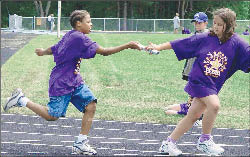 |
|
Track stars: A relay race at the NYSP at the University of Wisconsin, Eau Claire. Photo: Photo by Tom Patt |
A network of summer sports and health programs for poor youth is demonstrating that life goes on after your federal funds are axed – but not very well.
Since it was dropped from the federal budget last year, the National Youth Sports Program (NYSP) has shrunk from 200 sites to 50, leaving up to 50,000 kids without the free activities, meals and medical screening that it used to provide, according to a nonprofit that administers the program.
Its demise is a warning of sorts about the changing nature of youth recreation programs and the risk of relying on government funding.
Launched in 1968 as a pilot program by the National Collegiate Athletic Association (NCAA) and the President’s Council on Physical Fitness and Sports, the NYSP was adopted by the White House in 1969 and has been funded primarily by the U.S. Department of Health and Human Services. Aside from offering standard sports for 10- to 16-year-olds, the sites created their own special activities, such as fishing through the University of Toledo in Ohio, and crew teams through the University of Massachusetts at Lowell.
The hosting of local programs by universities was a key selling point, because it exposed low-income youth to the college atmosphere. The programs also included lessons about nutrition, math and science.
In recent years, however, a variety of forces worked both for and against the NYSP.
Overly at Ease?
On the one hand, the program provided exercise, nutritional instruction and medical screening at a time of rising concern about youth health. The program was simple to run and cost pennies by Washington standards: under $18 million in fiscal 2005.
But by operating for only about five weeks a year, the NYSP was never going to provide the kind of measurable results that increasingly help programs win funding these days. “Thirty-eight years later, it’s a different era,” said Dan Gould, director of the Institute for the Study of Youth Sports at Michigan State University. “There is more competition for philanthropic and government money. People want you to actually show” that you’re achieving measurable goals.
The National Youth Sports Corp., which administers the NYSP, recently explored hiring researchers to conduct an evaluation. But “it’s hard to make a strong case for what our program did in five weeks,” says corporation President Rochelle Taylor.
A study at Purdue University last year found that the program there improved participants’ attitudes toward education, self-image and sportsmanship.
Another problem: With more and more youth enrolled in sports programs run by recreation departments and nonprofits, many of which are affiliated with big national groups, the need for Congress to fund a separate youth sports organization seemed to fade.
“The first thing people see is ‘youth sports.’ They start thinking, ‘There are tons of youth sports out there,’ ” Taylor says. She says the NYSP struggled to convince people that it was significantly different from the likes of the Boys & Girls Clubs. It even considered changing its name in order to stress that it’s a holistic health program, not just for sports, but decided its brand was too valuable.
While the Clinton and Bush administrations repeatedly tried to de-fund NYSP in their budget proposals, Congress kept putting it back. Taylor suggests that the NYSP was not sufficiently worried. “We did not even have a lobbyist until the year we were losing our funding,” she says.
That was Daniel Wexler, a Washington lobbyist whom the corporation paid a total of $120,000 in 2005 and 2006, according to Senate records. But with mounting federal budget pressures brought on by two wars, two Gulf Coast hurricanes and tax cuts, NYSP was one of numerous social programs that got dropped or reduced in fiscal 2006.
Another factor, Wexler says, was that some congressmen erroneously thought that if funding was cut, the NCAA “would pick it up.”
Last summer, federal money left over from fiscal 2005 helped some sites continue. Efforts to restore funding in 2007 were thwarted when Congress used 2006 budget priorities and did not fund new projects.
The remaining NYSP sites get funding for meals from the U.S. Department of Agriculture’s Summer Food Service Program, as do many youth programs. But a dwindling number of sites remain.
Finding New Ways
One survivor is the program at the University of California at Davis. Through proceeds from a golf tournament, and grants and sponsorships from the likes of United Way, Ronald McDonald House and Clorox, the university covered the $120,000 budget for this summer, said Sam Blanco, NYSP project administrator at the school. The program will serve its usual 300 to 350 participants, but will operate for only four weeks, one less than in the past.
At Georgia Highlands College, the old NYSP was reinvented as a new program. The college and the nonprofit 100 Black Men of Rome/Northwest Georgia raised $15,000 to create Foundation Camp 2007.
The camp will run for only two weeks and will host 50 youths, compared with five weeks and 300 kids under the NYSP, said Greg Shropshire, president of 100 Black Men.
Most NYSPs, including the site at Central Carolina Community College in Sanford, N.C., couldn’t even get that far. Former project administrator Rob Miriello said the college is searching for funds through grants, but does not want to institute a participation fee, as some programs have done.
The corporation might suffer the same fate. It still helps local programs with administrative matters, such as providing insurance, and lobbies for federal funds. Wexler is trying to get money restored for fiscal 2008.
But Taylor says the corporation has shrunk from 12 employees to three, and adds, “We have to determine if we’re going to be able to continue.”
Contact: National Youth Sports Corp. (317) 727-6447, http://www.nyscorp.org.

























